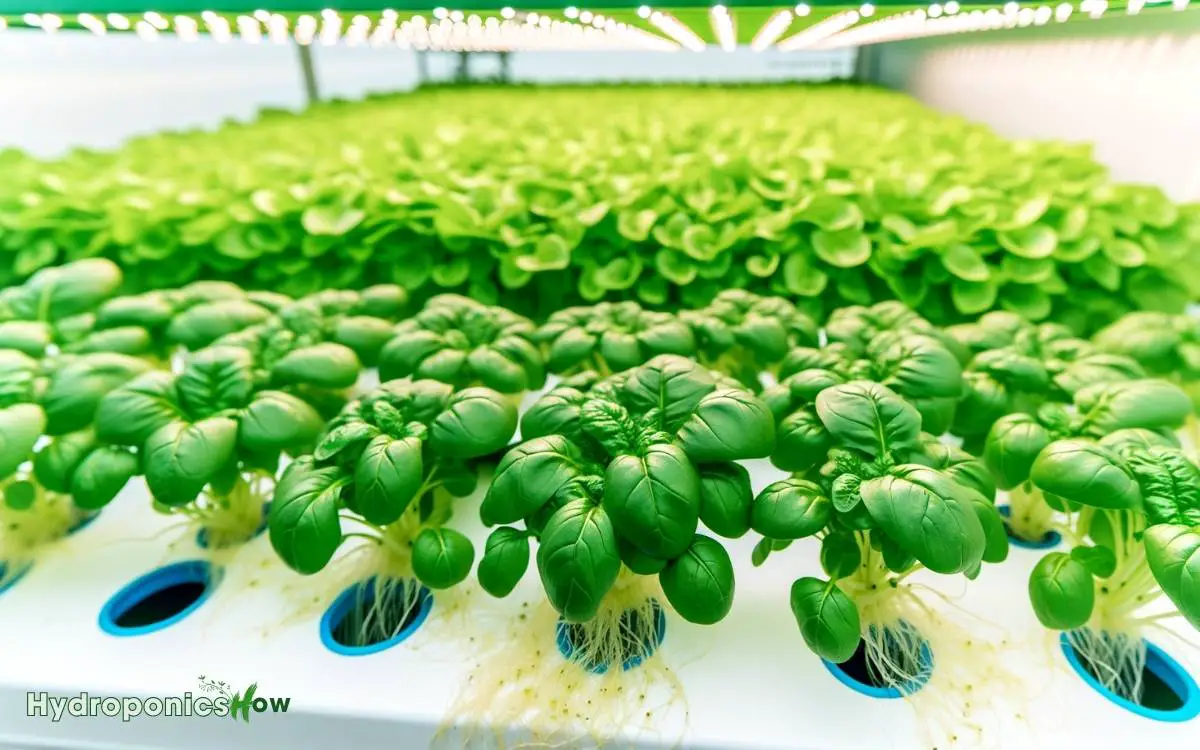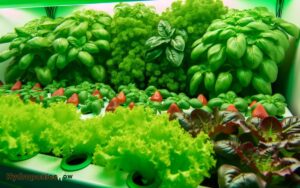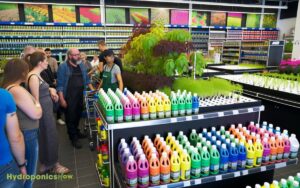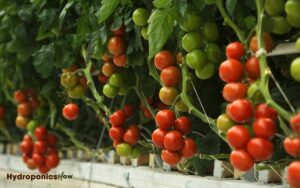Explore 3 Best Types of Hydroponic Systems for Baby Spinach
The Nutrient Film Technique (NFT) is the ideal hydroponic system for cultivating baby spinach. It provides a continuous thin film of nutrient-rich water, ensuring enhanced uptake of essential elements, superior leaf quality, and increased yields.
Additionally, NFT facilitates robust growth by maintaining ideal nutrient levels and oxygenation at the root zone.
For those seeking alternative systems, Deep Water Culture (DWC) and Aeroponics also offer efficient nutrient uptake and accelerated growth under controlled conditions.
Employing these methods can greatly improve resource efficiency, water conservation, and scalability. To explore various hydroponic techniques further and determine which system best suits your needs, proceed further. These innovative approaches not only maximize yield but also minimize environmental impact, making them ideal for sustainable agriculture. When selecting a system, it’s essential to consider factors such as space, budget, and crop preference. For instance, understanding the top tomato types for hydroponics can help you choose the best varieties that thrive in soilless environments.

Key Takeaways
Nutrient Film Technique (NFT)
The Nutrient Film Technique (NFT) is a hydroponic method that involves a thin film of nutrient-rich water continuously flowing over the roots of baby spinach plants, providing essential minerals and oxygen for ideal growth.
This system guarantees a consistent supply of nutrients and optimizes root aeration, critical for maximizing photosynthetic efficiency.
Evidence suggests that NFT can enhance the uptake of vital elements such as nitrogen, phosphorus, and potassium, leading to rapid vegetative growth. The technique’s design minimizes water usage, making it an environmentally sustainable option.
Research indicates that baby spinach grown using NFT exhibits superior leaf quality and higher yields compared to traditional soil cultivation, primarily due to the optimized nutrient delivery and reduced risk of soil-borne diseases.
Deep Water Culture (DWC)
Utilizing a submerged root environment, Deep Water Culture (DWC) enables baby spinach plants to thrive by suspending their roots directly in aerated, nutrient-rich water, fostering accelerated growth and robust health.
This method minimizes root diseases through constant oxygenation, provided by air stones or diffusers.
Empirical evidence supports DWC’s efficiency in promoting superior nutrient uptake and vigorous root development, essential for excellent leafy green production.
| Advantages | Disadvantages | Considerations |
|---|---|---|
| Rapid growth rates | Power outages risk | Consistent oxygenation |
| Simple setup | High water usage | Quality of nutrient mix |
| Low maintenance | Temperature control | Frequent monitoring |
Ebb and Flow System
In contrast to Deep Water Culture, the Ebb and Flow System employs periodic flooding and draining of the grow bed to deliver nutrients to baby spinach roots, optimizing nutrient absorption and oxygenation cycles.
This hydroponic method uses a timer-controlled pump to flood the grow bed with nutrient solution at intervals, allowing the roots to absorb nutrients before draining back into a reservoir.
The cyclical nature of this system promotes robust root development by alternating between nutrient-rich and oxygen-rich environments.
Studies indicate that Ebb and Flow systems are particularly effective for leafy greens like baby spinach, as the periodic drainage prevents root rot and promotes healthier growth.
Additionally, this method allows for flexibility in nutrient delivery schedules, enhancing overall crop yield.
Aeroponics
Aeroponics employs a misting system to deliver nutrient-rich water directly to the roots of baby spinach, optimizing nutrient uptake and oxygenation in a highly efficient manner.
This method utilizes fine mist nozzles that create a micro-environment around the root zone, enhancing the absorption of essential nutrients and dissolved oxygen.
Studies indicate that aeroponics can increase the growth rate of leafy greens by up to 50% compared to soil-based cultivation. Additionally, the absence of a growing medium reduces the risk of soil-borne pathogens, making aeroponics a sanitary option.
However, the system’s reliance on precise technology and potential for nozzle clogging necessitates diligent maintenance. Overall, aeroponics offers superior growth conditions for baby spinach, albeit with higher operational demands.
Wick System
The Wick System presents a cost-effective and straightforward approach to hydroponic cultivation, leveraging passive nutrient delivery mechanisms.
This method minimizes the need for active maintenance by utilizing capillary action to transport nutrients from the reservoir to the plant roots.
Consequently, it is particularly advantageous for growing baby spinach, requiring minimal technical oversight while ensuring consistent nutrient uptake.
Simple and Low-Cost
A wick system represents one of the most straightforward and budget-friendly methods for cultivating baby spinach hydroponically.
This system operates on capillary action, where nutrient solutions are drawn up through a wick from a reservoir into the growing medium.
Materials such as cotton or nylon serve as effective wicks. The primary advantage lies in its simplicity and minimal initial investment, making it accessible for small-scale or novice growers.
However, it is essential to monitor the nutrient solution levels consistently to prevent deficiencies.
Analytical evidence suggests that while the growth rate may be slower compared to more complex systems, the wick system’s low maintenance and operational costs offer a viable solution for producing healthy baby spinach without sophisticated technology.
Passive Nutrient Delivery
How does passive nutrient delivery via a wick system effectively sustain baby spinach growth in hydroponic setups?
The wick system operates on capillary action, where wicks made from absorbent materials such as cotton or nylon draw nutrient-rich solutions from a reservoir to the plant roots.
This method guarantees a continuous and consistent supply of essential nutrients and water, essential for the best growth of baby spinach.
Empirical evidence suggests that the wick system maintains adequate moisture levels, reducing the risk of overwatering or underwatering.
Additionally, the passive nature of this system minimizes the need for mechanical components, thereby reducing the likelihood of system failures.
Consequently, the wick system offers a reliable and efficient means to cultivate baby spinach in hydroponic environments.
Minimal Maintenance Required
Minimal maintenance is a notable advantage of the wick system in hydroponics, as it eliminates the need for frequent manual intervention and complex monitoring.
This system employs capillary action to deliver nutrient solutions to baby spinach roots, greatly reducing the necessity for pumps or electrical components. The simplicity of the wick system means fewer points of failure, ensuring operational stability.
Additionally, it requires minimal adjustments once set up, making it ideal for growers with limited time or technical expertise. Studies indicate that wick systems maintain consistent nutrient and moisture levels, fostering ideal growth conditions for baby spinach.
This reliability, coupled with reduced labor inputs, positions the wick system as an efficient choice for hydroponic spinach cultivation.
Drip System
The drip system offers a highly efficient mechanism for nutrient delivery, optimizing the growth conditions for baby spinach. This method guarantees targeted application of nutrient solutions directly to the root zone, minimizing waste and enhancing plant uptake.
Additionally, the drip system notably conserves water resources, making it a sustainable choice for hydroponic cultivation.
Nutrient Delivery Efficiency
Maximizing nutrient delivery efficiency in a hydroponic drip system is crucial for guaranteeing the healthy growth and high yield of baby spinach.
This system ensures that a precise mixture of water and nutrients is delivered directly to the plant’s root zone, optimizing absorption rates.
The drip system’s control over nutrient concentration and pH levels mitigates deficiencies and toxicities, promoting robust growth.
Additionally, the uniform distribution of nutrients prevents localized nutrient imbalances, which can hinder plant development.
Empirical studies have demonstrated that drip systems increase nutrient uptake efficiency by maintaining consistent moisture levels, reducing the risk of nutrient leaching.
Consequently, this method supports accelerated growth cycles and enhances the overall quality of baby spinach, making it a superior choice for hydroponic cultivation.
Water Conservation Benefits
Implementing a hydroponic drip system offers significant water conservation benefits by precisely regulating water delivery to the root zone, thereby minimizing wastage and enhancing resource efficiency.
This method guarantees that water is supplied directly to the plant’s needs, reducing evaporation and runoff.
Key advantages include:
- Precision Irrigation: Targeted water application minimizes waste and optimizes plant hydration.
- Reduced Evapotranspiration: Lower surface exposure reduces water loss due to evaporation.
- Closed-Loop Systems: Recirculation of water within the system further conserves resources.
- Scalability: Suitable for various scales, from small-scale home setups to large commercial operations.
These factors collectively contribute to sustainable water usage in hydroponic baby spinach cultivation, aligning with modern agricultural practices aimed at conserving essential resources.
Kratky Method
Among the various hydroponic techniques, the Kratky Method stands out for its simplicity and cost-effectiveness in cultivating baby spinach.
This passive system, which requires no electricity or pumps, involves suspending plants above a nutrient solution with their roots partially submerged. As plants absorb nutrients and water, the liquid level declines, creating an air gap essential for root oxygenation.
Research indicates that baby spinach grown via the Kratky Method exhibits strong growth rates and high yields, owing to efficient nutrient uptake and reduced root rot risk.
Additionally, this method minimizes labor and maintenance, making it particularly suitable for small-scale or beginner hydroponic gardeners. Its low initial setup costs and scalability further enhance its appeal for efficient baby spinach production.
Vertical Hydroponics
While the Kratky Method offers a straightforward approach to hydroponics, vertical hydroponics presents an innovative solution for maximizing space efficiency and crop yield in urban environments.
By stacking multiple layers of growing platforms, vertical hydroponic systems utilize vertical space effectively, which is particularly beneficial in areas with limited land availability.
This method is especially advantageous for cultivating baby spinach due to its rapid growth cycle and compact root system.
Key advantages of vertical hydroponics include:
- Space Utilization: Maximizes limited space by allowing multiple layers of plants.
- Increased Yield: Higher plant density per square meter compared to traditional methods.
- Resource Efficiency: Optimizes water and nutrient use through recirculating systems.
- Scalability: Easily scalable for both small-scale and commercial operations.
This technique is ideal for urban gardening and commercial farming alike.
Aquaponics
Aquaponics, an integrated system combining aquaculture and hydroponics, offers a sustainable and symbiotic environment for growing baby spinach by utilizing nutrient-rich water from fish tanks to nourish the plants.
This approach leverages the natural nitrogen cycle, where fish waste is converted by bacteria into essential nutrients for spinach growth, resulting in efficient nutrient uptake and reduced waste.
| Parameter | Aquaponics |
|---|---|
| Water Usage | Highly Efficient |
| Nutrient Source | Fish Waste |
| Plant Growth Rate | Moderate to High |
| System Complexity | High |
| Environmental Impact | Low |
The mutual benefits between fish and plants create a closed-loop system that minimizes resource consumption, making aquaponics a viable option for sustainable spinach cultivation. This method guarantees optimal growth conditions and aligns with eco-friendly practices.
Conclusion
In summation, the most suitable hydroponic system for cultivating baby spinach is akin to selecting the finest brush for a masterful painting.
Each method Nutrient Film Technique, Deep Water Culture, Ebb and Flow, Aeroponics, Wick System, Drip System, Kratky Method, Vertical Hydroponics, and Aquaponics—offers unique advantages and challenges.
However, the choice hinges upon specific needs such as space, resource availability, and growth efficiency.
An evidence-based analysis illuminates that tailored approaches yield the most bountiful harvests.






